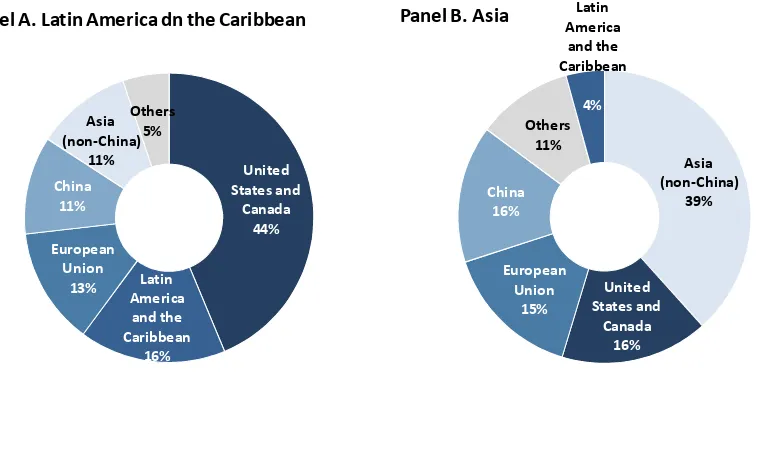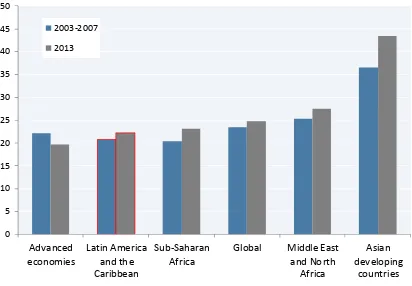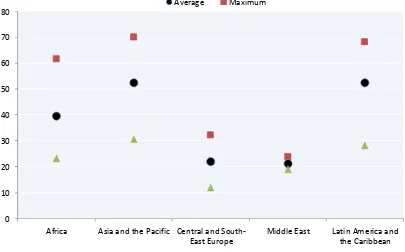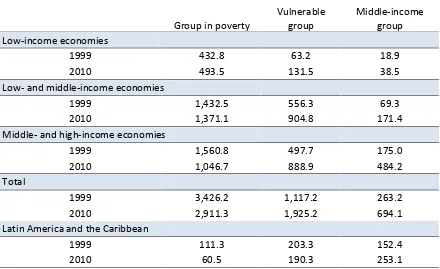S E P T E M B E R 2 0 1 4
Development and
employment in Latin America
and the Caribbean:
A look ahead
R AY M O N D T O R R E S
Research Department Working Paper No. 2
Development and employment in
Latin America and the Caribbean:
A look ahead
Document prepared
by the Research Department of the ILO
for the 18th American Regional Meeting
Raymond Torres and Elva López Mourelo
September 2014
Copyright © International Labour Organization 2014 First published 2014
Publications of the International Labour Office enjoy copyright under Protocol 2 of the Universal Copyright Convention. Nevertheless, short excerpts from them may be reproduced without authorization, on condition that the source is indicated. For rights of reproduction or translation, application should be made to ILO Publications (Rights and Permissions), International Labour Office, CH-1211 Geneva 22, Switzerland, or by email: pubdroit@ilo.org. The International Labour Office welcomes such applications.
Libraries, institutions and other users registered in the United Kingdom with the Copyright Licensing Agency, 90 Tottenham Court Road, London W1T 4LP [Fax: (+44) (0)20 7631 5500; email: cla@cla.co.uk], in the United States with the Copyright Clearance Center, 222 Rosewood Drive, Danvers, MA 01923 [Fax: (+1) (978) 750 4470; email: info@copyright.com] or in other countries with associated Reproduction Rights Organizations, may make photocopies in accordance with the licences issued to them for this purpose.
ILO Cataloguing in Publication Data
Torres, Raymond; López Mourelo, Elva
Development and employment in Latin America and the Carribean: a look ahead / Raymond Torres and Elva Lopez Mourelo ; International Labour Office, Research Department. - Geneva: ILO, 2014
Also available in Spanish: Desarrollo y empleo en América Latina y el Caribe: Una mirada hacia el futuro,
The designations employed in ILO publications, which are in conformity with United Nations practice, and the presentation of material therein do not imply the expression of any opinion whatsoever on the part of the International Labour Office concerning the legal status of any country, area or territory or of its authorities, or concerning the delimitation of its frontiers.
The responsibility for opinions expressed in signed articles, studies and other contributions rests solely with their authors, and publication does not constitute an endorsement by the International Labour Office of the opinions expressed in them.
Reference to names of firms and commercial products and processes does not imply their endorsement by the International Labour Office, and any failure to mention a particular firm, commercial product or process is not a sign of disapproval.
ILO publications can be obtained through major booksellers or ILO local offices in many countries, or direct from ILO Publications, International Labour Office, CH-1211 Geneva 22, Switzerland. Catalogues or lists of new publications are available free of charge from the above address, or by email: pubvente@ilo.org
Visit our website: www.ilo.org/publns
Abstract
Latin America and the Caribbean has, generally speaking, shown greater resilience in the face of the current economic crisis than other regions, both in terms of economic growth and employment. The countries of Latin America have performed well economically and their labour markets have not been particularly affected, in spite of the uncertainty that the global economy is currently experiencing. This notwithstanding, the region faces the challenge of capitalizing on its numerous achievements, whilst not losing sight of its weaknesses.
This document presents the most recent trends with regard to economic growth and employment in the region. In this context, it reflects on the slowdown in economic growth that has been observed recently in various Latin American countries, and highlights the different macroeconomic and labour-market challenges that the region confronts. Specifically, the paper advocates a more diversified productive structure that would favour the export of products with higher value added - which, in turn, requires investment in education to develop a workforce possessed of the skills needed for this structural change. Latin America and the Caribbean must also address the social challenge posed by the need to reduce income inequalities, extend social protection and reduce the weight of the informal sector in the region’s economy.
Lastly, this document argues for the importance of designing and coordinating a set of policies to be implemented at both national and international level. Stronger regional economic integration and the promotion of internal sources of growth would contribute to industrial development and the diversification of the economic base. Also, better regulation of financial flows and stimulation of public and private investment would lead to stronger macroeconomic stability. With regard to social and labour-market policies, programmes that transfer cash to households, as well as measures that support the transition to formality, are extremely useful tools to fight poverty and social exclusion, and to promote inclusive economic growth. Finally, it is fundamental that these social protection measures be complemented by well-designed active labour-market policies that support the integration into the labour force of those most at risk of exclusion.
Keywords: promotion of employment / economic growth / labour market / social protection / development policy / Latin America / Caribbean
iv Research Department Working Paper No. 2
Contents
Abstract ... iii
1. Latin America and the Caribbean in the global context ... 1
2. Challenges facing Latin America and the Caribbean ... 3
2.1. Challenges related to the growth model ... 3
2.2. Challenges related to the labour market ... 6
3. Reflections on policy ... 9
References ... 11
Tables
Table 1 Unemployment rate by region: 2007, 2012, 2013 and 2014 ... Table 2 Size of different income groups by group of countries ...
Figures
1. Latin America and the Caribbean in the global context
The state of the global economy is uncertain, with prospects of modest growth over an extended period. The IMF’s most recent projections forecast global growth of 3.6 per cent in 2014, a rate 0.6 percentage points higher than that recorded for 2013 (Figure 1). While this figure justifies a degree of optimism regarding a greater global economic recovery, it is important to remember that this growth rate is 0.2 percentage points lower than that recorded, on average, over the post-crisis period (2010-2013). Moreover, as Global Employment Trends 2014 indicates, the growth projections made by the main international organizations have been repeatedly revised down over recent years (ILO, 2014a). Therefore, it is reasonable to doubt the accuracy of the predictions for 2014.
Weak global economic growth is essentially rooted in the advanced economies, which are predicted to grow by 2.2 per cent in 2014 (Figure 1). This slow growth, in turn, has its roots in advanced countries’ unresolved financial sector problems and high levels of public indebtedness, coupled with fiscal consolidation measures that limit economic growth and job creation.
The unfavourable economic climate in the advanced countries is having negative collateral effects on some emerging economies, including China and India. Until a relatively short time ago, international trade was the principal mechanism for global transmission of the negative effects of the crisis. However, the anticipated and narrow monetary stimulus provided by the central banks of some advanced economies has created uncertainty and volatility in the global financial markets (ILO, 2014b). As various sources indicate, this financial instability particularly affects emerging and developing economies, which tend to have fewer defence mechanisms (Ffrench-Davis, 2012). Regions such as Latin America and the Caribbean have been affected by the increased volatility of international capital flows, which has obliged them to rapidly adjust their macroeconomic policy in order to limit the impact on exchange rates, while also weakening their national economies.
2 Research Department Working Paper No. 2
As a result of the uncertain economic situation, the global unemployment rate is predicted to reach 6 per cent in 2014, 0.6 percentage points higher than its pre-crisis level. In addition, the level of global unemployment is estimated to remain virtually constant over the next five years - meaning it will continue to be half a percentage point higher than before the crisis. While it is true that in emerging and developing countries the situation as regards unemployment is more positive, the knock-on effect from the advanced economies has resulted in an acceleration in unemployment growth in most countries and regions (ILO, 2014b). For example, in 2014 unemployment rate is forecast to grow by 0.2 percentage points in Central and South-East Europe, and by 0.1 percentage points in both South and East Asia. Similarly, the economic deceleration of 2013 is expected to affect the Latin American labour market over the course of 2014. In fact, unemployment rate in the region is predicted to slightly increase, from 6.2 per cent in 2013 to 6.3 per cent in 2014 (Table 1).
Figure 1 Real annual GDP growth, 2007-2014
Source: IMF (2014)
Global
Advanced economies Emerging and developing
economies
Latin Am erica and the Caribbe an
-4 -2 0 2 4 6 8 10
Table 1 Unemployment rate by region: 2007, 2012, 2013 and 2014
Note: The data for 2014 are projections.
Source: ILO, Trends Econometric Models, April 2014 (ILO, 2014b).
2. Challenges facing Latin America and the Caribbean
Based on the economic and labour market context described in the previous section, the region should make the most of its numerous achievements without losing sight of its weaknesses, particularly in the light of the deepening of the crisis in the advanced countries. Indeed, Latin American countries face various macroeconomic and labour market challenges.
2.1. Challenges related to the growth model
Exports have played a crucial role in the economic evolution of Latin America and the Caribbean, especially from the 1980s onwards. In concrete terms, exports accounted for approximately 15 per cent of Latin America’s GDP in the early 1980s, but grew to account for over 25 per cent of its GDP over the first decade of the new millennium. In 2012 exports represented 24.7 per cent of Latin America’s GDP, 1.5 percentage points less than the previous year and 1.7 percentage points less than prior to the crisis.
4 Research Department Working Paper No. 2
As well as having a macroeconomic impact, the concentration of Latin America’s exports and the consequent lack of diversified production structures have a direct effect on the skills of the labour force, and, in turn, labour productivity. Although labour productivity in the region recovered quickly from the 2009 fall, it has continued to grow at a rate below the global average. Further, projections contained in Global Employment Trends 2014 suggest that this tendency will continue over the next four years (Figure 3).
Weak labour productivity in Latin America and the Caribbean reflects the limitations the region faces with regard to the generation of productive capacity. This negative drift could be reversed through greater investment, particularly in sectors with a big technological component. However, investment as a percentage of GDP has stagnated over the last decade; in 2013 it represented 22.1 per cent of GDP. Moreover, levels of investment are low in comparison with other emerging economies. In 2013, for example, Latin American investment as a percentage of GDP was 20 percentage points lower than that recorded for Asian developing countries (Figure 4).
Figure 2 Latin American and Asian exports by destination region, 2012
Source: International Trade Centre.
Panel A. Latin America dn the Caribbean
Figure 3 Labour productivity index, 2000-2018 (2000=100)
Notes: *2013 are preliminary estimates; 2014-18 are projections. Source: ILO (2014a).
Figure 4 Investment as a percentage of GDP, by region
6 Research Department Working Paper No. 2
The decrease in exports and investment in Latin America and the Caribbean can probably be attributed to the fact that some of the region’s principal trading and investment partners are among those worst hit by the crisis. Furthermore, advanced economies’ relapse could spark new capital flows, seeking the higher profitability of emerging markets. This bigger flow of foreign direct investment could cause exchange rate fluctuations that would affect the external competitiveness of Latin America and the Caribbean, and have a significant distorting effect on the region’s real economy.
2.2. Challenges related to the labour market
On top of macroeconomic challenges, Latin America must respond to its social and labour-market challenges. The need for a more diversified production structure that would enable the region to export products with more value added requires investment in education, to create a skilled labour force able to support such a structural transformation. At the same time, Latin America must extend social protection, and reduce the weight of the informal sector in the region’s economy. Despite significant improvements in the last decade (particularly in Argentina and Brazil), approximately 50 per cent of non-agricultural employment in 2011 was informal. This problem is particularly pressing in some countries, including Bolivia, Honduras and Peru, where informal employment accounts for approximately 70 per cent of non-agricultural employment (ILO, 2012).
Figure 5 Estimated informal employment shares, 2011 (per cent)
Note: Calculations are based on a sample of 49 countries (eight countries in Africa, 11 countries in Asia and the Pacific, 11 countries in Central and South-East Europe, 16 countries in Latin America and the Caribbean and three countries in the Middle East).
Source: ILO (2014a).
Africa Asia and the Pacific Central and
South-East Europe
Middle East Latin America and
the Caribbean
In the majority of Latin American countries, the wealth generated by labour productivity has not been distributed evenly between wages and profits. In fact, the share of GDP allocated to labour decreased almost continually between 2000 and 2008. There has, however, been a noteworthy change in this trend since the economic crisis in 2009 (Figure 6). On the other hand, real wages in the region have improved, although there are significant inequalities between countries. While real wages grew in Brazil and Paraguay by more than 4 per cent in 2012, in countries like Colombia and Mexico they increased by only 1 per cent. Similarly, there is mixed progress with regard to the minimum wage. While there has been a considerable increase in the real minimum wage in some countries, such as Brazil and Uruguay, in other territories including El Salvador, Mexico and Panama, the increase has scarcely offset price rises and, therefore, its effect on workers’ purchasing power has been neutral (ILO, 2013a).
Over the last decade, the Latin American region has seen a significant reduction in income inequality. Yet the degree of inequality remains high by international standards. The Gini coefficient is higher than 45 per cent for the majority of countries in the region, and higher than 55 per cent for some, such as Colombia and Honduras. On the other hand, according to the World of Work Report 2013, economic growth, better quality jobs and the reduction of inequalities have contributed, over the
Figure 6 Share of labour incomes in GDP, 1998-2010 (2000=100)
Notes:The data for Latin America and the Caribbean are based on the simple average of data from the 12 countries for which information was available: Bolivia, Brazil, Chile, Colombia, Costa Rica, Cuba, Mexico, Panama, Paraguay, Peru, Trinidad and Tobago and the Bolivarian Republic of Venezuela.
Source: World of Work Report 2014 (ILO, 2014b). 90
Latin America and the Caribbean North America
8 Research Department Working Paper No. 2
course of the last decade, to the growth of Latin America’s middle class. To be precise, Latin America’s middle-income group grew by more than 100 million in only ten years, from 152 million people in 1999 to 253 million in 2010 (Table 2). Moreover, in most countries in the region, the increase in the number of people on middle incomes was greater than the increase in the number of people barely above the poverty threshold. This swelling was particularly notable in Brazil and Ecuador, where the middle-income groups grew between 1999 and 2010 by 15.8 and 14.6 percentage points, respectively (ILO, 2013b).1
Table 2 Size of different income groups by group of countries (millions of people)
Group in poverty
Source: World of Work Report 2013 (ILO, 2013b), based on the PovcalNet database of the World Bank.
1
3. Reflections on policy
Latin America and the Caribbean has been one of the regions to be only moderately affected by the current economic crisis and its impact on the labour market. The region has also continued to show good economic and employment performance over the last few years, despite the uncertain state of the global economy. In order to make the most of its achievements thus far, without losing sight of its weaknesses, it is essential to design and coordinate policies at both national and international level.
• Regional integration and industrial policy. Given the weak growth prospects of the majority of their trading partners, the countries of Latin America and the Caribbean could accelerate their development through a coherent policy strategy based on stronger regional economic integration and the promotion of internal sources of growth. Moreover, regional integration could support industrial development and the diversification of the economic base, which is often dominated by the exploitation of natural resources. In this regard, the Latin American region could undertake to implement similar processes to those that other regions have used to cooperate in inter-regional trade. Asia’s regional integration process, for example, deserves particular attention.
• Reform of the financial system. To achieve stronger macroeconomic stability, the internal capital market must be reformed and financial flows better regulated. National banks for development, such as Banco Nacional de Desenvolvimento Econômico e Social do Brasil (BNDES), are notable initiatives in this arena.
• Promotion of investment: It is worth highlighting the value that support for public and private investment by the region’s governments would have. As the World of Work Report 2013
indicates, if policies designed to stimulate investment (such as tax exemptions) target the most labour-intensive sectors or activities that generate energy savings, they are likely to have a positive impact on employment. In addition, an increase in public investment has positive effects on productivity and, if well directed, can also promote private investment, particularly in those regions most in need of investment in basic infrastructure (ILO, 2013b).
• Support for economic assistance programmes. Social protection policies, such as cash transfer programmes to households, can be highly useful tools to combat poverty and social exclusion and support inclusive economic growth. In the same way, a minimum wage can act as a social protection floor in the face of salary cuts, and can stimulate demand in periods of crisis. Brazil serves to illustrate this - it has made considerable progress in terms of poverty reduction, owing, in part, to a more solid national minimum wage and to the cash transfer programme “Bolsa família”.
10 Research Department Working Paper No. 2
References
Ffrench-Davis, R. 2012. “Employment and real macroeconomic stability: The regressive role of financial flows in Latin America”, in International Labour Review, Vol. 151, No. 1-2, pp. 21-41.
International Labour Organization (ILO). 2012. 2012 Labour Overview: Latin America and the Caribbean, ILO Regional Office for Latin America and the Caribbean (Lima).
―. 2013a. 2013 Labour Overview: Latin America and the Caribbean, ILO Regional Office for Latin America and the Caribbean (Lima).
―. 2013b. World of Work Report 2013: Repairing the economic and social fabric (Geneva).
―. 2014a. Global Employment Trends 2014: Risk of a jobless recovery? (Geneva).
―. 2014b. World of Work Report 2014: Developing with Jobs (Geneva).
International Monetary Fund (IMF). 2013. World Economic Outlook: Transitions and tensions, October 2013 (Washington, D.C.).




